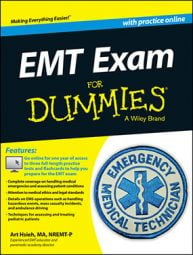You will need to know about allergic reactions and anaphylaxis for the EMT exam. The immune system is key to your ability to ward off foreign bodies that can make you sick — bacteria, viruses, and other organisms, as well as proteins that can be irritating to the inside of your body, such as pollen.
When it detects an invader, the immune system triggers a series of responses that results in bringing white blood cells to the source, which attack and hopefully kill off the offending body. The immediate area surrounding the source becomes swollen with plasma that’s carrying the white blood cells.
This is all well and good, and works very well. However, in some cases the immune system becomes a bit hyperactive, causing the body to shift more fluid than what is needed to do the job.
Think of pollen, for example. You and many other people may experience an allergic reaction when exposed to it. Your nose gets stuffy and you may have to blow out mucous. Your eyes get watery and you may end up sneezing and coughing. All of these reactions are ways for the body to try to keep as much of the pollen out of itself as possible.
As annoying as this may be, it’s a simple allergic reaction. In more serious allergic reactions, the swelling may be in the skin, causing little red welts called hives or urticaria to appear. The skin can become very itchy and the patient may feel very uncomfortable. An antihistamine medication such as diphenhydramine (Benadryl) reduces the intensity of the reaction.
Unfortunately for some people, their immune systems go overboard, causing an anaphylactic reaction. In anaphylaxis, the swelling can happen in the upper and lower airways, making it very difficult to breathe. The bronchioles begin to constrict, causing wheezing. A patient may complain of tightening in the throat.
The veins may dilate massively, causing blood pressure to fall and plasma to leak into the skin, causing a bloated appearance. Anaphylaxis is a very serious, potentially life-threatening condition. Patients who know they are anaphylactic may be prescribed epinephrine autoinjectors. You may need to assist these patients with their use.
Know the difference between an allergic reaction and anaphylaxis. Assisting a patient with an epinephrine autoinjector can be life-saving in anaphylaxis, but potentially dangerous in a simple allergic reaction because epinephrine puts huge demands on the heart and could cause a heart attack. The benefits outweigh the risk in anaphylaxis, where the blood pressure is very low and you want to improve cardiac outcome.
In an allergic reaction, blood pressure is close to normal already, so placing the patient in a position of comfort and monitoring vital signs is appropriate.
A 14-year-old female is anxious and feeling “itchy all over” after eating fried food. She is alert, with pale, warm, dry skin. There are hives on her chest and arms. Her lung sounds are clear and no stridor is evident. Her blood pressure is 110/70 mm Hg, her heart rate is 90, and she is breathing 20 times per minute.
She has an allergy to peanuts and has an epinephrine autoinjector and diphenhydramine (Benadryl) tablets with her. You should
(A)continue your secondary assessment.
(B)assist the patient with her epinephrine autoinjector.
(C)administer two diphenhydramine tablets.
(D)lay her supine or left lateral recumbent.
The correct answer is Choice (A). You can come to this conclusion based on excluding the other answers: She’s not having an anaphylactic reaction, Choice (B); you are not permitted to assist the patient with nonauthorized medications, Choice (C); and having her lie down, Choice (D), won’t have any benefit.

